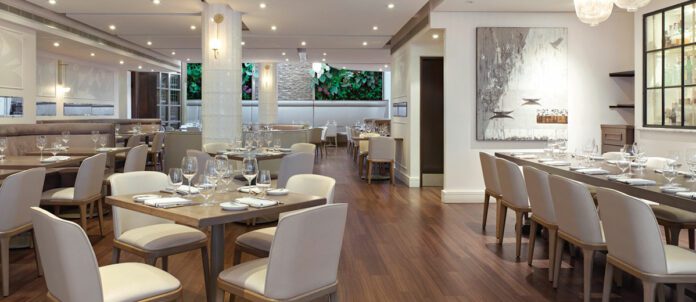Wine drinkers and wine producers pivoted to virtual events and tastings during the COVID-19 pandemic, however, the experience of entertaining, educating and selling is shifting back to restaurants.
“Fine-dining took a big hit during the pandemic and consumers began to drink and learn more about wine at home,” says Justin Madol, sommelier at Toronto’s Michelin-starred Don Alfonso 1890. “Since customers have returned to restaurants, there has been a demand for tableside wine presentation to elevate the dining experience.”
Running a proper wine service depends on the setting. “Wine etiquette is interesting. Sommeliers need to adapt to the setting they’re in,” says Madol. “Not every restaurant needs the same level of service around its wine program, but hospitality and understanding guests’ needs is key across all segments.”
At Don Alfonso 1890, Madol will approach a table from the right-hand side, framing a bottle of wine with a napkin to present it to the guests. After he confirms the producer, style of wine, area of origin and vintage with the guests, Madol will use a side station to open and decant the wine, as well as check for any faults. Common faults include TCA (also referred to as cork taint), which is a chemical that can give wine a musty, moldy paper smell; high levels of volatile acidity; and volatile sulfur compounds called mercaptans, which smell like rotten eggs.
Once Madol approves the wine, he will pour a small amount for the guest of honour to taste before pouring for the rest of the table.
“If a guest disapproves of a wine, it’s important to remove the bottle from the table and bring out something they will enjoy,” says Madol. “Bottles that have been turned away can serve another purpose, whether it’s used for a pairing later in the evening or for staff training.”
A perfect harmony should be attained when wine and food are paired. At Don Alfonso 1890, its tasting menu includes an eel gelato with sturgeon caviar, wild rose-scented tagliatelle, pulverized egg yolk and minced wild herbs, which is paired with Zmé, From Black to White II Bianco, Veneto IGT, Italy, 2019.
“This quirky wine is basically a red grape that mutated into a white grape,” says Madol. “The wine has a touch of plurality and is herbaceous with a subtle texture. It was perfect for this dish. Another example on our tasting menu is the I Vermicelli allo Sgombro, which we’ve paired with a Verdicchio. It’s a simple white wine with a fresh, salty character that complements the mackerel in the dish.”
James Pollock, CAPS-certified sommelier, wine director at Toronto’s Sassafraz Restaurant and wine educator at George Brown College says, “It helps to have a pad of paper to write information down, such as the vintage year or the name of a producer when servicing guests. Some wine lists can be very detailed, with a single producer and several vintages of their wine stored in a cellar. Always write it down and repeat the order back to the guests.”
Sassafraz’s wine list currently offer selections from 16 countries, including more than 30 products that can be enjoyed by the glass. Its wines-by-the-glass program now includes Enomatic selections, which allows the restaurant to keep open bottles of wine in a preservation system to maintain freshness. Pollock says pouring wine around a table in a clockwise fashion is best. Once the bottle has been approved, it’s important not to overfill one’s glass. The standard pour of wine is five ounces.
Additionally, Pollock notes that “the guests should never have to touch the wine bottle at a restaurant. The sommelier or the server should always top up the glasses, especially if they’re allowing smaller pours into the glass. As a service professional, this allows you to approach the table and be present without actually having to say anything. It provides an opportunity for guests to engage with the server should they need anything. It’s also improper for a server to take a glass off the table to re-fill it. Touching of the objects on the table is minimal.”
Generating wine sales boils down to two things, says Madol. “The wine program has to suit the restaurant concept and its food. If that’s curated properly, there will be natural excitement about what you’re selling and how it pairs together with the food. Customers feed off the energy of a salesperson. The second thing is serving customers what they like. Never push a guest toward something they’re not going to enjoy.”
BY NICOLE DI TOMASSO


















